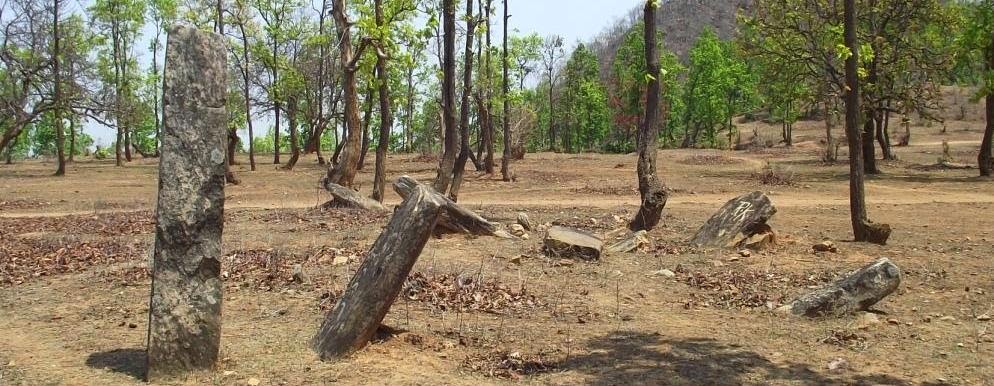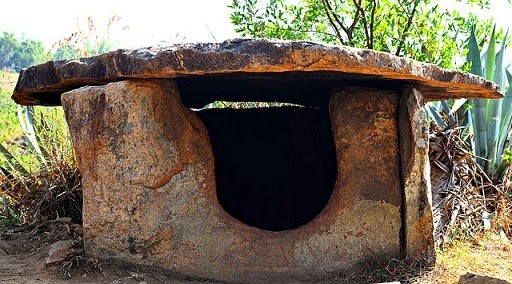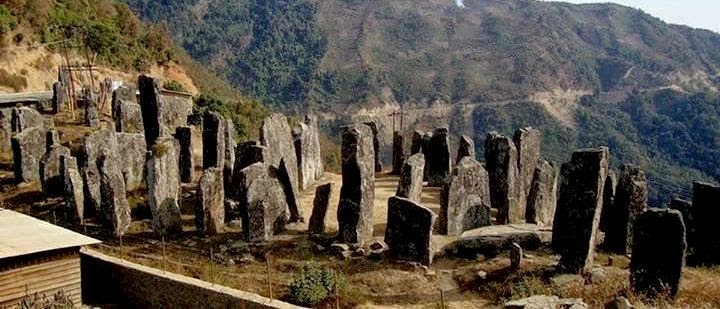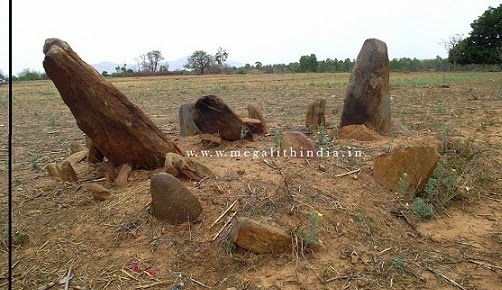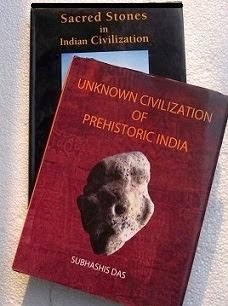Monday, 20 April 2015
Megalithic sites discovered in Telengana
Monday, April 20, 2015
Subhashis Das.
2 comments
FARMER IN TELEGANA STUMBLES ON A MEGALITH WHILE PLOUGHING WITH TRACTOR A rare Megalithic cist burial (Gudu samadhi) belonging between 1000 BCE and 600 CE has been discovered at Dasaram village close to Musi river in Nereducherla mandal in Nalgonda district in Telengana District. Annapureddy Chandra Reddy, a farmer, stumbled upon the burial when the tractor ploughing agricultural land. Archaeology and Museums Department officials led by Assistant Director D. Ramulu Nayak and former conservator Y. Bhanu Murthy inspected the site and concluded that it was cist burial belonging to Megalithic period. Speaking to The Hindu, Mr. Murthy said apart from the burial ground, they found stones used for sharpening weapons and slingshots used for protecting crops from birds. “People of that time used to bury the things used by the deceased person during interment,” he said. The burial has stones on four sides and capstone on the top. Similar burials were found at archaeological sites located at Phanigiri and another near Bhongir in district in the past, but they were yet to be excavated. Shockingly, Mr. Murthy said, the local farmers have damaged at least 15 to 20 such burials unknowingly while ploughing their farms. The archaeological site is still having at least 30 more such burials which would give more insights once excavated. He said he also had written to Director of Archaeology and Museums requesting for sanction of grants to take up the excavation of the rare site. Both the officials said there could have been a habitation of people, who buried their near and dear ones, 2 km away from the present find. Farmers near the Musi had in the past found red and black ware. Mr. Chandra Reddy said he did not know the structure holds such an importance until the Archaeology Department officials told them. CREDIT: THE HINDU.
Read More
Ruined megalithic site dated back to 500 BC found in Kadapa.
Monday, April 20, 2015
Subhashis Das.
2 comments
A megalithic burial site has been discovered near Devandlapalli village in Rayavaram panchayat of Tsundupalle mandal in Kadapa district. In archaeological explorations conducted by Associate Professor G. Sambasiva Reddy, Assistant Professor of History and Archaeology and Assistant Profesor of Geology K. Raghu Babu of Yogi Vemana University, a complex of 20 megalithic monuments were noticed and some of them were dolmens and remaining were dolmen encircles with slabs the left over monuments, dolmenoids-cists encircles with slabs. All the monuments were disturbed by treasure hunters, every burial encountered with pottery pieces normally black and red ware, red ware etc. were noticed. Significantly, two of the dolmens on north-western orthostat bearing on the inner surface depicting tortoise, leaf-like structures, human with weapon and sun like diagrams with red ochre and white pigments were noticed. Another dolmen depicted two elephants alongside each other and elephant human figures drawn in white pigment. Chronologically the megalithic assigned in Rayalaseema region to 500 BC based on C14 (Carbon) dating method.The exploration team appealed to District Collector V. Anil Kumar, officials of the State Archaeology and Hyderabad circle of Archaeological Survey of India to protect the megalithic monumental complex in Kadapa district for future generations. SOURCE: THE HINDU
Read More
Friday, 20 March 2015
Vernal Equinox in Punkri Burwadih Megaliths. Hazaribagh. Jharkhand. East India.
Friday, March 20, 2015
Subhashis Das.
No comments
Self portrait at the Punkri Burwadih Megaliths. The crowd had begun to gather in the Punkri Burwadih megalithic complex from about 5.00 AM. We arrived at around 5.45 A.M. The sun here was to rise at about 6.06 A.M. A day prior we laid down lime markers to indicate people where to stand and from where to view the sunrise. Marking with lime to show the alignment of the stones and the place to stand Two menhirs M2 and M3 can be seen positioned adjacent to each other so that a "V" notch is formed. I have observed that menhirs in the state are oriented towards the mid-winter sunrise. Similarly the menhirs in this complex were made to face the Winter Solstice sunrise. A small stone marked A is placed in a North-South orientation about a few meters towards the NW of the two menhirs. At about 93" towards the Summer Solstice observing point to its right is the point from where the Equinox Sunrises can be viewed through the V; in other words from this point the V is to its Due East. The three menhirs M1, M2 and M3. The North-South aligned stone A. Waiting eagerly for the sun to rise. The anxious wait for the sun and there is the solar orb visible right in the centre of the V, behind the hill cameras flash. Why did the ancients observe the Equinox Sunrise ? This is something difficult to answer as the ancient megalithic astronomer-priests left behind no written documents. But we can speculate from the positioning of the stones that these were surely placed after observing the movements of the sun for reasons more than one. Explaining the functioning of the Punkri Burwadih megalithic observatory to the crowd One reason for such arrangements of the stones could be perhaps to observe the Equinoxes and Summer Solstice sunrises from which they could fix these significant days in the year for their day-to-day life as marriages and agriculture et al.The sun is cradled inside the V between the two male female menhirs. Therefore Punkri Burwadi megalithic complex functioned not only as a burial but also as an observatory of the transits of the sun for it to perform as a calendar for the community. An Indian Hindu even today wouldn't move a foot without referring to their calendars. What does the sun in the "V" signify? We need to realise that that megaliths were appendages of the fertility cult, rather a cult related to birth and death, worship of the sexual organs and the wombs, and worship of the ancestor. All these found expression in symbols. Of the two menhirs of M2 and M3 one is of red colour comprising of hematite which perhaps symbolises the female whereas the one adjacent to it as the male. The "V" in the middle of both the male and the female stones is symbol of the pubic triangle or the female vulva. Through the symbolical vagina of the V notch therefore the new sun takes birth on Equinox mornings exactly though the middle of the V vulva as consequence of the union of M2 and M3. It is widely believed that on the Equinox day the new sun was born. Therefore on this day or the day after was considered to be the beginning of the New Year for the megalithic multitude.
Read More
Monday, 22 December 2014
MEGALITHS OF HAZARIBAGH
Monday, December 22, 2014
Subhashis Das.
5 comments

I am privileged to live in a middle-sized semi-urban town of Hazaribagh in North Jharkhand state of East India. My privilege emerges from reasons confined not only to my town's surrounding being densely wooded or she having a lovely weather but for me precisely for the numerous varied megaliths her environs house. The uniqueness of Hazaribagh megaliths is that they differ from the megaliths of other region. Apart from beingsepulchral monuments Hazaribagh also houses a few very ancient megaliths which reveal stunning astronomy and mathematics as a testimony of these sciences prevalent among the tribals of the ancient times. The photographs below are of a few of these primitive monuments. These were built at a very ancient time and can be seen in and around Hazaribagh. Sadly many of these megaliths below have been lost in lack of protection as the Indian Government does not care much for the protection of her own culture and heritage particularly tribal megaliths. This megalithic site is Lati on the way to Itkhori. The very ancient Raja Gosaiwn menhir in Silwar. This menhir is still worshipped by the villagers as Raja Gosaiwn. These depressions on the rock are called cupules or cupmarks and are appendages of megaliths. This cupuled rock is adjacent to the Raja Gosaiwn menhir in Silwar. These are supposed to have been made thousands years ago and are believed to be the symbol of the erstwhile Mother Goddess. An Oraon dolmen in the large megalithic site of Banjha. Megalithic site of Gidhore. I stand in the ancient megalithic site of Basantpur near Ghatotand. This very beautiful Mundari site is Gurua near Seotagarha. MEGALITHS OF ROLA (CHANO). A very young Prantik (Bumpy), my son sits on the elephant behind the Gibraltar House on Jabra Road. MEGALITHS OF NAPO. DOLMEN IN KESURA. MEGALITHS OF BANADAG. The very ancient menhir at Kallu Chowk, Lohsinghna. Sujit stands near a very large menhir in Barath. The astronomical pillar of Furuka few kms away from Ichak. This megalith has to be seen to be believed. This megalithic site in Jabra Road and is worshipped by the locals as the Pacahi Baba. This worship has protected this very ancient megalithic site. The megaliths of Amnari. The beautiful Birbir megalithic site. The astronomical megaliths of Punkri Burwadih. THE EQUINOX SUNRISE THOUGH THE MENHIRS OF PUNKRI BURWADIH. This is a lizard shaped capstone of a dolmen in Banadag. The tall menhirs of Punri Mandar megalithic burial site. Lean-support menhirs in Rahriya Tand.
Read More
ECHO IN PUNKRI BURWADIH MEGALITHS
Monday, December 22, 2014
Subhashis Das.
No comments

The film shoot. It happened during a film shoot in the megalithic complex. I was standing about 2/3 mtrs NE of the menhir B while the camera was positioned about 7/8 mtrs to my opposite. The director wanted me to walk towards the camera while giving the discourse on the megalith. In the process while walking about 2 mtrs opposite the menhir B, I was suddenly taken aback as I felt that I was speaking in an open auditorium. I stopped immediately and called the crew explaining them the phenomenon. They soon rushed in to find the occurrence of the same phenomenon while speaking from a particular spot. I let the discovery be for that day and continued with the shoot. I returned the next morning to research on the acoustics in the megaliths. I had read of sound effects in many European megaliths and was skeptical about them but to happen with me in the Punkri Burwadih megaliths itself was indeed something unanticipated. But how can an echo ensue in the open, this was maddening ? The next morning I set out for Punkri Burweadih accompanied by a small team including Prantik my son, my co-worker, Abhisek Mishra, a Senior Geologist from Srinagar, Kashmir in North India and a host of Geology students of the Vinoba Bhabe University. Prantik, Abhishek and I stand at the marker stone and speak towards the menhir B to experience echo effect. The natural depression on the menhir can be seen. That the megalith is inclined to the front in the photograph can also be perceived. Working on the menhir which creates the echo. Arriving at the megaliths I sought for the spot from where the reverberation was occurring. I discovered a small stone dug into earth at a distance of about 72" from the menhir; a standard megalithic measurement in this region of India. I learnt the stone in the spot must have been dug in by the ancients which surely served as a marker indicating the exact spot from which the echo could be obtained. We all huddled around that stone and began conducting tests of the echo. We discovered that for the best results we were required to speak louder facing the the menhir B. We were amazed at the effect...as if we were conversing in an open room. How could the ancients acquire the feat in this wide open, we wondered. We then began working on the menhir to find the stone was slightly tilted towards the marker stone. We also spotted a natural depression at the middle of the eastern surface of the stone with a tentative height of about 28" and a width of about 14" to 15" and it was this particular cavity which was causing the reverberation, ofcourse the incline was also aiding to the effect. We were required to confirm this hypothesis, so Prantik, Abhishek and an another youngster stood in front of the menhir obstructing the depression while I yelled. There was no echo and once I talked louder removing the three fellows; bingo...the echo had resumed. So indeed it were both the depression and the incline that was creating the echo. Such basic science and such a marvellous effect. That would mean they deliberately searched for a stone with such a depression on it so that the echo could be produced with its help. The exact angle of the tilt therefore was mandatory for the ancient megalithic astronomers to procure the reverberation from the exact spot of 72"; a standard megalithic measurement which must have been sacred from them. Many megaliths in the region has been found to be of 72". 72" according to ancient Indian measurements is I (one) danda or is 8 vitastas or vittas (one vitatsta is equal to 9" or the span between the smallest finger and the thumb). But why echo? The echo must have been serving a socio/religious/magical purpose in the megaliths which much have been under the custody of the astronomer priests. I thereafter invited a few Physics professors of the Post Graduate Dept of the Vinoba Bhabey University to work on the echo effect in Punkri Burwadih. I of course had a hard time explaining to them what a megalith was. It is unfortunate despite living in a tribal state people at large are ignorant of tribal megaliths. So one fine winter morning the University team comprised of Physics professors and PG students headed by Dr.Navin Chandra of the Physics Dept accompanied me to the Punkri Burwadih megaliths to study its newly discovered echo effects. Professors and PG students of Physics of Vinoba Bhabhe University tries to unravel the mystery of the echo by covering the menhir. A curtain is placed at the left side of the menhir to block the draft whether that changes the quality of the echo. The scholars expressed their utmost shock to find the echo and without wasting much time they fell to work. They had bought curtains and tried blocking the wind from the sides of the menhir B to find why and how the reverberation worked. Hours of research too had them conclude that it was the depression and the tilt of the menhir that was creating the echo.
Read More
Older Posts
MEGALITHIC ACTIVITIES IN INDIA
THE PIONEER features "CHOKAHATU MEGALITHS"
First ever song composed on a megalith in India. Rajat Chandra sings on the fascinating megaliths of Punkri Birwadih:
Megalithic burials of the dolmen kind of Andhra Pradesh:
Rare megalithic sites discovered in Chattisgarh:
More than 200 megalithic sites found in Dhamtari and Mahasamund districts of Chattisgarh.
Copper beads found during excavations in megaliths of Kerala. Read on:
A huge mysterious Peru type feature of the letter VI has been discovered on a hillock in Gujarat by Geology scholars. Chances are that the feature could be man made. Read on...
The 'kodakkal' or the 'Umbrella Stones', a type of unique dolmens typical only to Kerala lie in utter neglect. As-Prof Devdas now heads a study on the megaliths of Kerala. Visit:http://varnam.nationalinterest.in/2010/12/saving-megalithic-sites/
125 megaliths have been discovered in the region of Junapani in Vidharba.
About 3000 year old megaliths have been discovered in Nagpur Amravati road.
3000 year old megaliths have been discovered in a college campus of Khammam of A.P. College authorities have planned to protect them. Great Job. Hope there were more like them.
The legendary Burjhaom megaliths of Kashmir: https://www.jstor.org/stable/985068?seq=1

